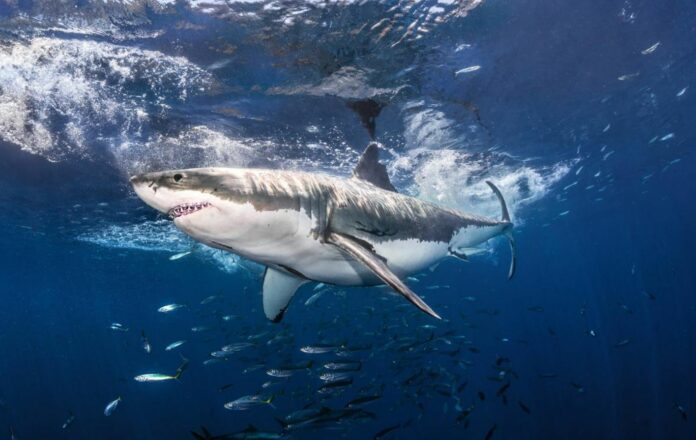Shark-Eat-Shark: Great Whites Prefer Fellow Sharks Over Seals, NatGeo Reveals
Researchers have made a fascinating discovery about the dining habits of great white sharks in South Africa’s Mossel Bay, as revealed in a NatGeo show. Contrary to popular belief, these formidable predators are not primarily feasting on seals but rather on other sharks. It appears that the great whites in Mossel Bay are targeting smaller sharks that gather near river mouths for breeding.
Mossel Bay is known as a hotspot for great white sharks, with an estimated 40 to 60 individuals present in its waters at any given time. Initially, scientists believed that the sharks were attracted to the area due to the abundant presence of cape fur seals at Seal Island, a small rocky landmass located approximately 2,000 feet (610 meters) from the shore and home to around 4,000 seals.
However, there was a discrepancy in the numbers. If seals were indeed the primary prey for these sharks, researchers estimated that around 1,500 seals would be killed during the hunting season. Yet, only 150 seals were found in the stomachs of the predators.
So, what are the great whites eating the rest of the time?
Lacey Williams, head field specialist at Oceans Research, expressed “Our hunch is that they are spending more time hunting other sharks than seals.”
To unveil the truth, Williams and Enrico Gennari, a shark scientist specializing in great white studies, used tracking data to monitor the sharks’ movements during seal breeding season when seals enter the water in smaller numbers, making them less abundant as prey. They discovered that the sharks were congregating around three river mouths, where various smaller shark species reside, breed, and feed. They deployed underwater cameras to observe the happenings beneath the surface.
The team captured dramatic footage of a catshark swimming along the seafloor.
However, as a great white shark approached, the cat shark froze, appearing to play dead.
Neil Hammerschlag, director of the shark research and conservation program at the University of Miami, described this behavior as extraordinary since the catshark was even holding its breath, avoiding the pumping of water through its gills that would create a weak electric field detectable by the great white shark.
“I’ve never seen footage of this kind ever before,” he described.
“When you actually look at the behavior of the sharks on the videos, they act like they’re scared of great white sharks. And you know what runs from white sharks? White shark food.”
They then shifted their focus to the potential prey species that the great white sharks might be targeting—smooth-hound sharks (Mustelus mustelus), which grow up to approximately 6 feet (1.8 meters) in length.
They attached tags to 20 smooth-hound sharks, which would emit a distinct signal if the tagged shark was consumed. The team witnessed the smooth-hound sharks being devoured one by one, with Gennari noting that “70% of tagged sharks have been eaten.”
To confirm the identity of the predator preying on the tagged smooth-hound sharks, the team collected muscle tissue from great white sharks. The fatty acids in the tissue leave a distinct signature, revealing the predator’s diet.
The findings showed that the great white sharks’ diets were predominantly composed of other sharks.
Hammerschlag explained, “We knew that white sharks eat other sharks, but this study is revealing the extent may be greater than previously appreciated, even in white sharks living near seal colonies.”
Hammerschlag further noted that our understanding of white shark feeding behavior might be biased due to the ease with which humans can observe them in seal colonies. Catching seals, on the other hand, is no easy task, as they are intelligent and aggressive creatures armed with large canines and claws that can cause harm to white sharks.
Many white sharks bear wounds from encounters with seals, which suggests that hunting and consuming other sharks is likely easier and safer for them.
The documentary “Shark Eat Shark” will premiere on National Geographic on July 2.
Image Credit: Shutterstock
